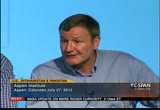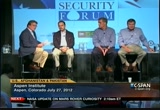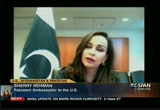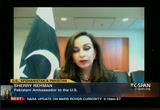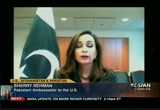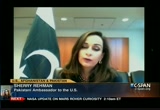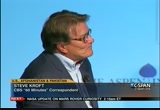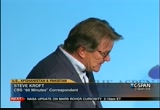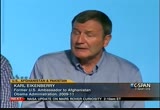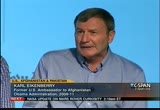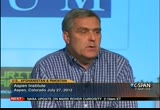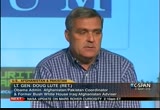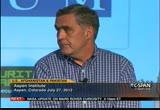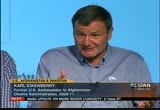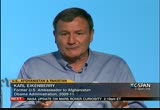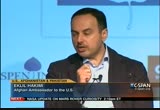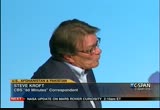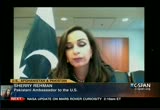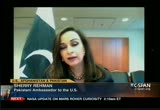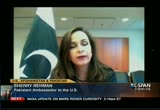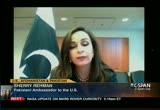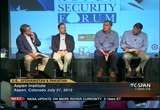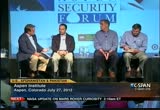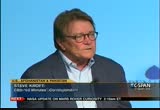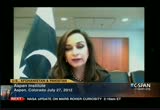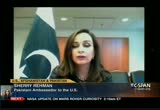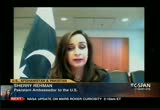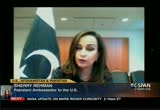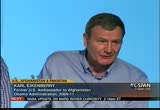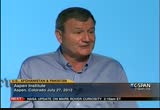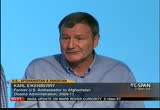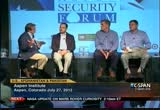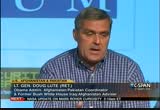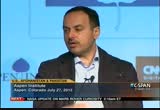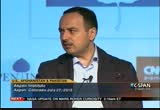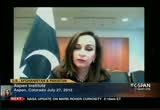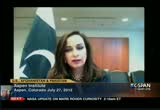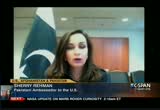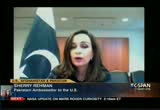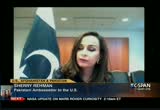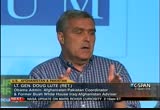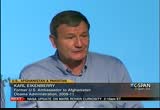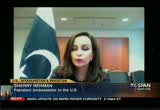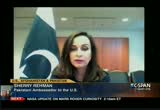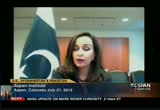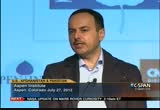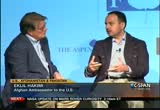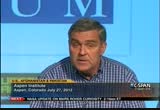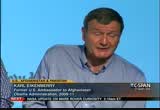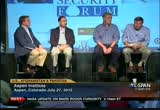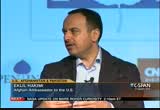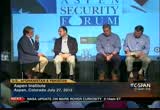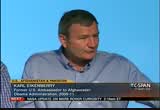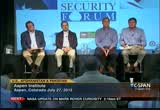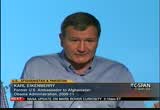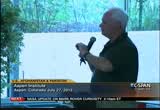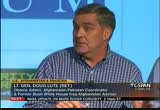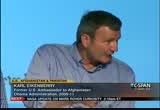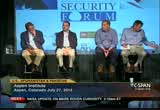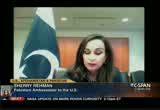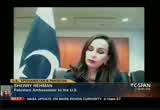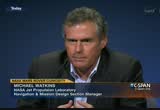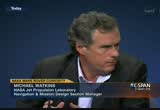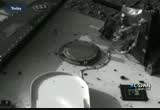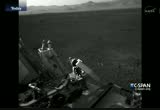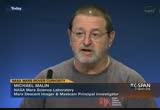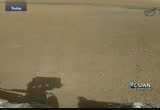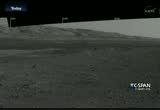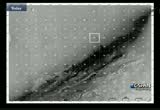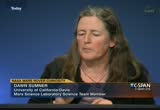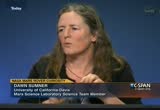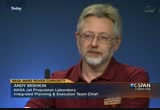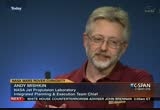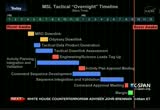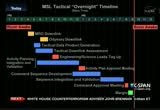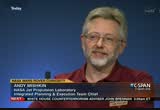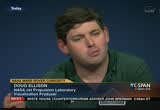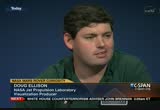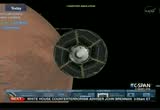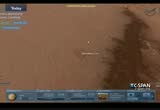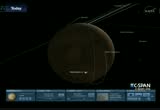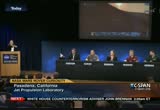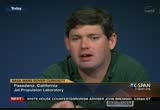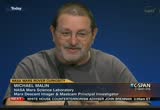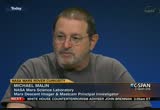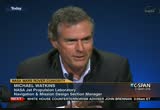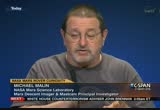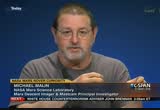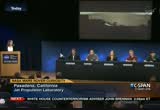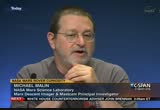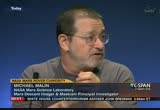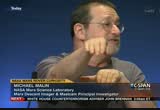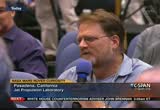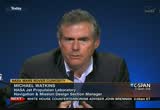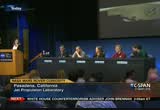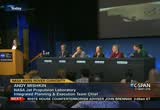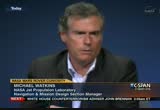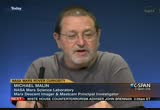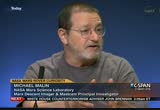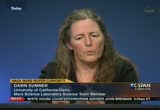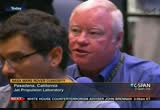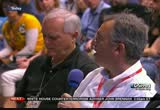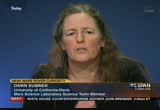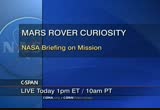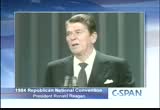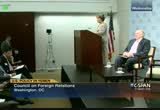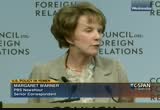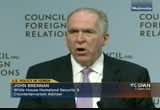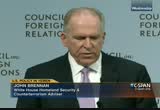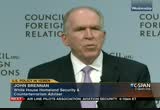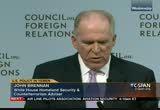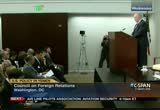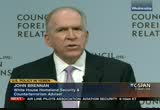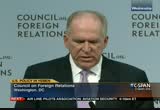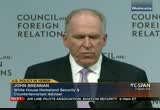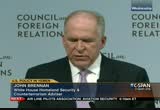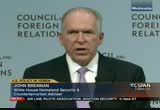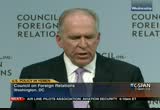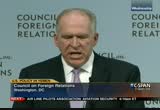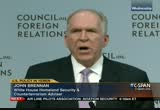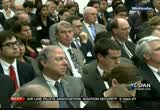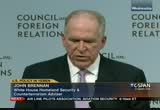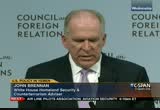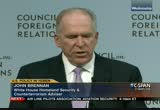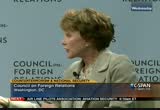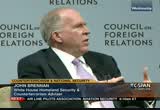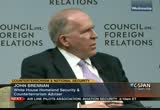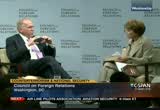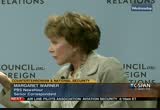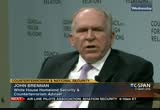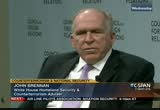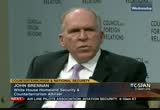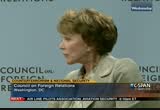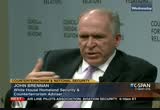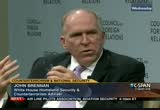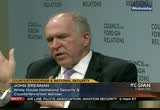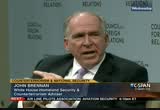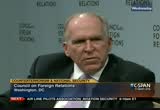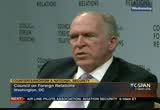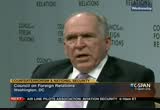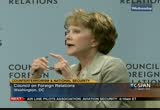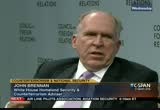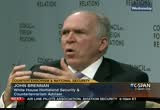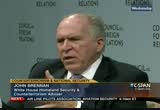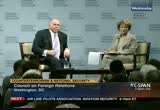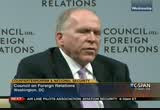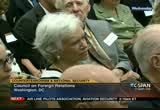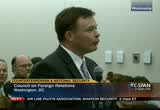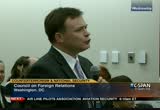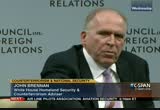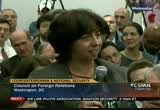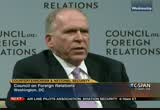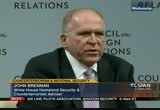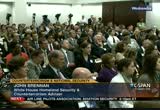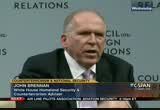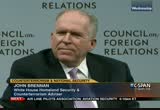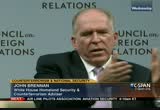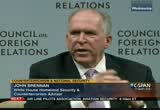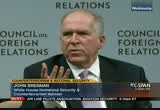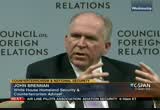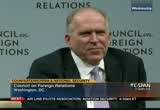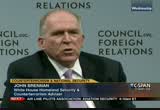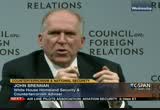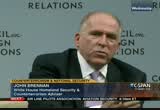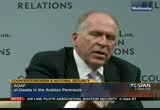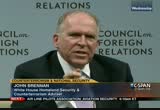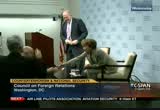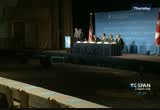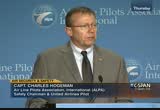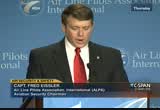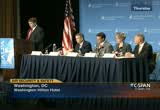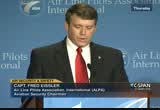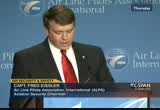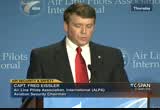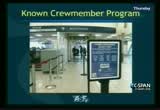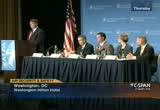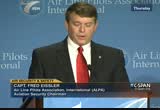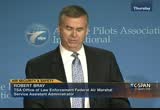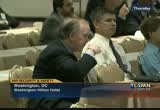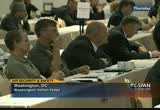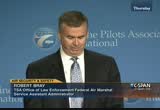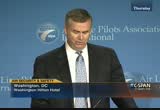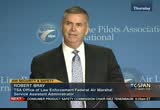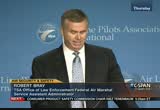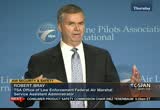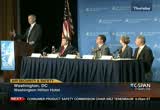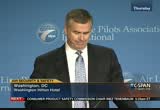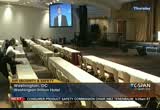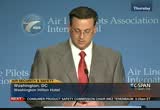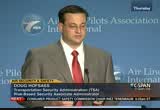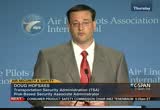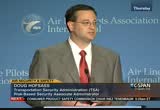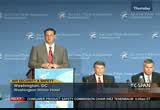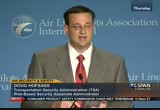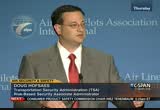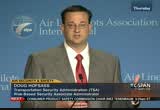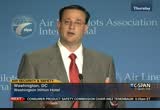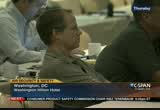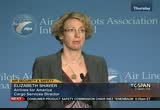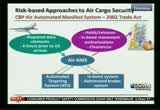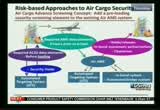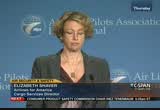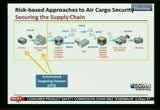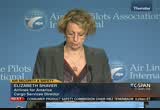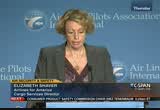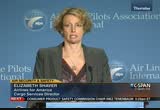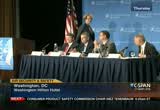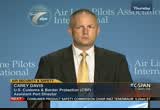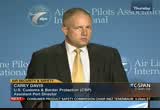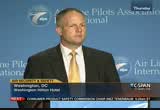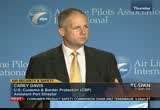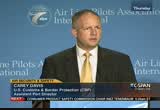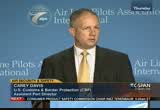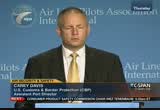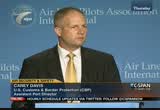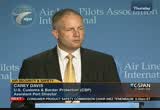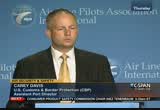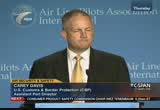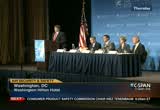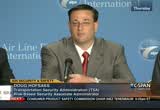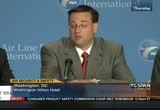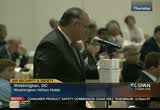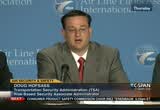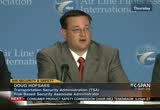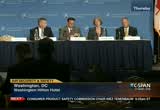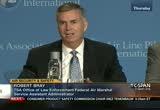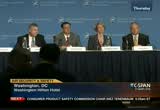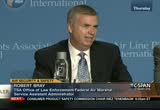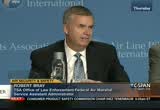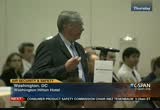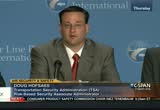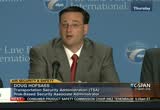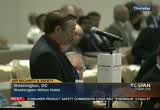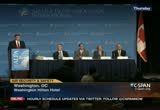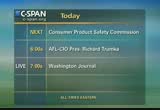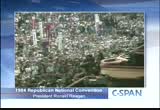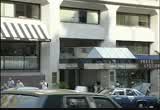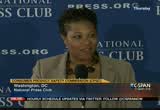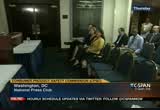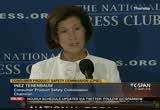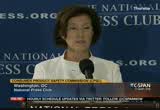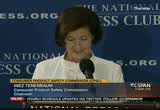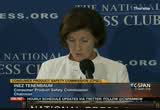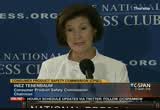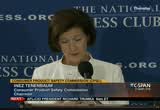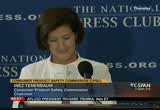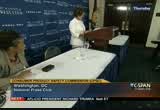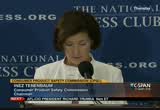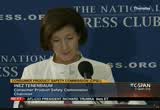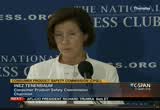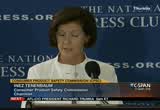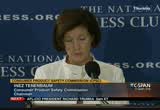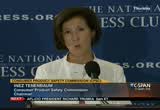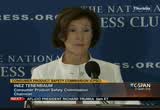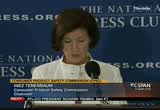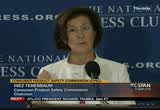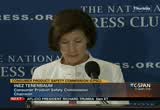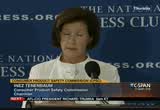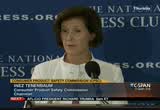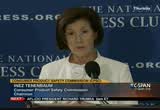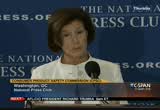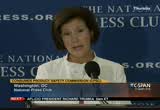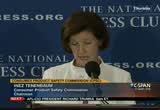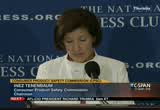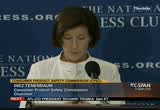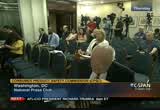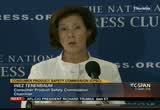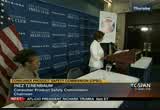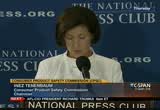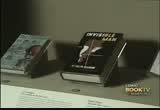tv Capitol Hill Hearings CSPAN August 10, 2012 1:00am-6:00am EDT
1:00 am
education. in 2001 there were 1 million afghans going to school. now there are 4 7 million. 40% of them are women. health care services has been transformed. will these gains all hold? will there be reversals? what we also do not know and historians will have to tell us -- maybe the panel will talk about this -- was the end ways and means we adopted for the campaign in afghanistan, where they sound? the third would be just to agree with what doug had said. the mission is not over. the mission is being redefined. is going from one or the international community has been in the lead and of the critical domains to one in which the afghans are in the lead. we are going from a position of lead to a position of support. is a change of mission, not an end of mission.
1:01 am
>> i want to hear what ambassador raymond has to say about this. what is the position from afghanistan? crux i certainly share the hope and vision that you have articulated. afghanistan is looking to a future where were finally comes to an end and clearly wants to be in the region. pakistan is committed to maintaining the peace, security, and civility. we look forward to a time where there is a measure of sustainability and afghanistan. we hope to support all efforts in that endeavor. very quickly, i would like to say that most important in all of this is that afghanistan belongs to afghanistan time, which is an effort we all have
1:02 am
to bring capacity and resources to. i say all because there is the united states with its big footprint. we are next door. to every difficult time and talents, we have supported afghanistan. i stress the position by saying, one of the primary concerns of women all over the world -- s p not just for pakistan -- is the status and position of women in the future where we hope there is not a vacuum in areas where local forces are not strong enough's or cohesive enough to bring it to gather the level of defense
1:03 am
needed to maintain the gains. we are obviously going to do our best to ensure that not just our border areas, but there is a security vacuum there often, those become -- they do not maintain sanctuaries for terrorists. we have sanctuaries on both sides, which is struggling for pakistan. really i think we lost the peace. we may have won the war, but we lost the peace. we have to be in a position where if we think we have won the war, we have to worry about
1:04 am
protecting a piece that will show the way forward to a secure, stable, and economically viable afghanistan that can meet its own needs. we may be a few miles away from that. i think our job here is to without meddling to ensure it is able to remain stable, cohesive, and in the days to come. pakistan is engaged. we will continue the intensification of the dialogue at all levels. and we really hope the level of interdiction at the international border between afghanistan and pakistan goes
1:05 am
up. we are beginning to see a little bit of blow back from redeployment in afghanistan. i do hope a great deal of what we look towards in the future is going to go beyond the planning stages. execution of policy is crucial. maintaining the gains made by nato, isaf, and afghanistan should not be wasted. that should be our main goal right now. to preserve security and stability for all components of the population. >> i have a question for general eikenberry. i want to go back to the figures mentioned here. i can see that we killed osama bin laden. i will can see that the
1:06 am
deterioration -- i will can see that the deterioration of that organization al qaeda in afghanistan has been severely damaged. but we are talking huge numbers here. we are talking to thousand americans killed, 16 million americans wounded. $400 billion. and we are leaving a situation where the talent and still has a very robust defense -- taliban still has a robust defense. they have sanctuaries on the borders. i am sure the ambassador would agree, there is still a great deal of corruption. i do not think anyone believes that the taliban will be defeated or the government of pakistan is going to be a functioning western style government.
1:07 am
i guess what i am saying is, just cutting our losses right now because it is proven to be too difficult to do all of the things we had talked about doing -- too expensive than life and blood to continue this for an indefinite period. is that the reason for these decisions and this current policy? >> look at the gains we have made. i will not repeat those. this audience is sophisticated enough to know what the baseline looks like. i think going for the transition strategy that has been outlined in sanctioned by the united nations is a sound way ahead. there are challenges with pakistan right now. pakistan is not on the side so to speak, this transition becomes much more problematic in
1:08 am
terms of treasure and more lives. there are challenges with the afghan national security forces with their sustainability and their capabilities. there are challenges on the economic domain that as for the level of international aid starts to decline over the next few years, it will have a shock effect on the afghan economy. there are problems with the afghan governments. there are problems with accountability of the government. to say that at this point we need to continue to double down on our efforts, i think we are added. in the united states, look at our own economic problems. something that really struck me coming home from overseas is the extent of our economic problems. we have infrastructure problems and education problems. i do not think the united states can afford to continue to invest in campaigns like iraq in afghanistan like we have over
1:09 am
the past decade. the transition has a reasonable possibility of success. we reached a point here in terms of our own means that are available. i think frankly in terms of the afghans it is time for the transition to take place. i am reading right now washington life. i came across as he talked about dealing with the french, washington saying if we're going to win our liberty, our army has to be the one to win the battles. we needed the french, but it is hours to win. we have reached a point where we have done a lot. there is a good foundation. we will continue to do more. is over to the afghans at this point. >> if you ask americans in the
1:10 am
wake of 9/11 what price would you be willing to pay to buy a decade without -- remember the days? i have my personal memories. everybody has their personal memories what happened in the immediate aftermath of 9/11. who would have thought 10 years without another repeat with al qaeda. who would have paid 10 years ago for the dismantlement and destruction that we see, ardsley but they have acknowledged over the past day and a half. not only have we been safe in terms of treasure and lives and so forth, but it has not been -- in has not gone without value. we really have gotten after al qaeda. they are on the edge of defeat.
1:11 am
frankly, as a 10-year investment, at least one american here that sounds like a reasonable price to pay. what you think it has been worth the investment? >> any individual life -- there is probably somebody in this audience who has lost a loved one. for that individual and family, it will never be worth it. the question had to do with america as a nation. americans bought 10 years of security from al qaeda and has -- and we have bought ourselves and side of defeating the movement. the core of the movement in pakistan and the border region. to me, never negating the individual losses that got us there and the first place, it seems that is a national price worth paying.
1:12 am
>> go-ahead. what do you agree also it was worth it? >> i agree. the way that doug framed it. if historians look back over the last 10 years and a rock and afghanistan, will they conclude that we needed to spend as much treasure as we did, as many lives. it is hardwood you are in the midst of a campaign and at war to try to think through all the uncertainties and come up with the optimal strategy. however, having said that, i do think the united states must conduct a good review of the wars we have fought. just several brief points about this. the starting point of our counterinsurgency strategy, a good first principle stated, we are there to protect the populations. we accept that.
1:13 am
what does that mean? to protect against insurgents? yes. against drug cartels? i am not sure. against the tribe on the other side of the hill versus the try we are aligned with for the past five years? these are the questions that we develop a doctrine. without questioning the doctor and we start to accept that as a strategy. there is one other point that i think needs to be examined in the wars that we fought. we had a contract in the united states over the years between unspoken contract between the civilian leadership and the military leadership of our country. over the past decade, our military has started to get in more and more areas that go far from the huntington model of the military's there to manage violence. we give them autonomy and oversight in that domain.
1:14 am
my concern over the past decade in the wars we have fought, our military has gone into anti- corruption and on a goes. as that starts to erode from the most specific definition of what a professional officer does, manager violence, i think accountability begins to suffer in the military ranks as well. >> to remind the american public, why you have engaged in afghanistan in the first place. that was because the u.s. security receives threats from that part of the world. terrorist groups use that against the u.s. 3000 innocent americans lost
1:15 am
their lives. because of that. all this blood invested there. also, when afghans played -- when afghans paid the price, 1 million afghans died and 1.5 disabled. and we defeated the soviet union. at that time also afghanistan abandon the. again 10 years of that, we were really engaged. i think we should be honest to say that the security of afghanistan, how it links the security in the region and also security in the u.s. >> you made reference earlier -- >> can i come in? >> i have a special question for you. you made a statement that
1:16 am
without the cooperation of pakistan this was going to be extremely difficult to do. there was a time when the united states and pakistan war allies. that seems to have ended. friends and allies. that seems to have ended. i think three out of the four people in pakistan right now consider the united states an enemy of pakistan. millions of people are asking the question, is pakistan friend or foe? what is the answer to that? >> very quickly, i think the united states and pakistan have been through an extraordinarily difficult time over the past
1:17 am
seven months. it was suspended because we had 24 soldiers killed at the border by nato and isaf forces. doors were unlocked when an apology clean up both sides to prevent it from spiraling down. yes, you have talked about this. i think it still is very strong really. a strong commitment on both sides. i can speak for pakistan that we see very little value and not rebuilding our ties with the united states and afghanistan. we are intensifying our engagement with all of our neighbors on both sides. the united states has been an ally and friend it through many phases of our history and
1:18 am
relationship. i sympathize with the ambassador who says afghanistan was abandoned. there is a problem. pakistan is -- we were in chicago at the summit. we were there for giving our support to the project. to say we do not want a repeat of the 1990's. we do not want another security vacuum again. we do not want to afghanistan to slide into civil war. we have a high stake in their security. in 12 years when you say, it has been defeated with pakistan and constant marches against and
1:19 am
cooperation in the field. we have captured and brought to justice or have handed over to the americans over 250 high- value targets. we now are looking at a degraded core. we hope to be able to deceive them -- the feed to them with american cooperation but without impossible demands. everybody is in citing losses. we empathize and sympathize. where is the sympathy for pakistan on having lost 42,000 lives in the last 12 years since we committed ourselves to the war? this is not a grievance narrative i want to bring to this. we want to engage in a constructive and very concrete conversation. we can take both of our games
1:20 am
for them prepare for a time when the american presence obviously has gone down. as we are told, there will be an american presence in afghanistan. but we hope once again that the capacity and capability of the forces and their policing mechanisms remain of the quality and caliber that can take on what we hear. we hear about in search and violence. this adds to pakistan's anxiety. it really is important for us to cooperate. we do look to the united states to not make what i call an irresponsible exit. i hope that is the way we will look at it in the future. >> let me just come in and
1:21 am
undermine -- underlined what she just said about a common interest and our two countries. that is the ultimate achievement of this core goal, to defeat al qaeda. as she rightly said, there have been more al qaeda leaders and operatives captured and killed and pakistan on than anywhere else in the world. the other core common interests that she highlights is the stability in afghanistan. there is no stability in afghanistan that does not involve pakistan on. there is no stability of pakistan on the design of afghanistan. we have a common interest to get this right on both sides. >> secretary of defense panetta indicated he sees no reason -- he sees no reason to end the drone strikes across the border.
1:22 am
there was a pakistan a doctor in prison right now. sentenced to 33 years for treason for assisting americans in the search for osama bin laden. what does that say about our relationship with pakistan where it would seem they have more loyalties to osama bin laden than they do to the united states? you are talking about an international fugitive wanted all over the world and somebody goes to jail and prison for treason for trying to turn him in? >> steve, i defer to the ambassador on that. in a word i call it outrages. >> can you explain that decision? this is one of the problems with the relationship right now. americans look at that decision.
1:23 am
they say, what is going on inside the pakistan government? what is going on inside the courts? they clearly seem to hate us. >> if i may interject here. i do not think there is any question of hate here. pakistan is are in a place where we are looking for our first democratic transition. our institutions have found -- our records are looking with. we have lost a prime minister to the actions of the supreme court in pakistan. we are working according to our constitutional law. let me just say very clearly. he had no idea he was looking for a summit and leighton. do understand for pakistan, and
1:24 am
the ground, he was contracting with a foreign intelligence agency without anybody's position. he was contracting with groups who are be heading our soldiers. he was contracting with many people on the ground. he had no clue he was engaged in this historic fight against -- a search for a sum of been laden. i would also like to point out that -- osama bin laden. i would also like to point out, if you heard president obama's speech, he recognized pakistan's cooperation leading up to the eventual killing and search. i think there is no question. it really pains me to hear pakistan is being put in a category of a country that is harboring or is looking to
1:25 am
preserve osama bin laden's sanctuary. all other high-value targets were found with pakistan's cooperation. that is not the profile of a country that is looking to hide osama bin laden. we were all excited when he was found. when it was discovered it was without our participation, it was with our assistance at some level. that incident and did straining factions because it was a strike into pakistan we would have certainly cooperated. we would have said share the intelligence with us and we will go after him. i cannot really say what can or should be done with him. he is facing the courts. he has access to justice. he will appeal his sentence if
1:26 am
he made. that is really a choice he has to make. to tell us we cannot put -- send it to court a doctor who has put into jeopardy children who are now facing critical vaccines -- what he has done is he has done a great deal of our workers on the ground, put them in danger. our primary vaccinators. he has endangered people's lives. we are not a country looking to be -- this is one of the charges i think holds up against the doctor. it is not about who in some -- who assisted the united states to find osama bin laden.
1:27 am
we have been assisting the united states. i have to say with a disrespect, it is quite outrageous to say pakistan has been -- i have to say with due respect it is outrageous to say pakistan after all the sacrifices -- >> i think general has something to say. >> another good thing about leaving service is to get your first name back. three quick points. not to disagree with our pakistan ambassador. . no. 1. the u.s. popularity favorability from pakistan is 7% right now. that is even lower than u.s.
1:28 am
population favorability ratings for our congress. that is very low. it is not entirely due to pakistan. those ratings are like that. the second point is, i think for the united states we are simply over the past 10 years are not clear what pakistan's interests are. i am not sure pakistan is clear or unified on this. on the one hand if you are pakistan and you are part of the national security apparatus and looking at the potential for a week afghanistan, then staying aligned with the afghan taliban makes good sense. if afghanistan were to collapse, they will once again become the playground of great games. there is an argument they would want to hedge. on the other hand you can have a view that the pakistanis think afghanistan will succeed
1:29 am
brilliantly. you may want to heads with the taliban as well. there can oculus remains opaque to us. the third point, -- their calculus remains opaque. the transition, this first successful civilian transition, that is critical. stepping back we always will come to the conclusion that pakistan needs to get a strong civilian government that controls its military. the nature of the relationship has been one in which the urgent has always trumped the long term strategic importance. the urgent is most recently the war on terror. compromises' deal directly with the military. it deals with the isi. of course that makes sense for
1:30 am
the united states of america with the consequences of 9/11. i am not sure that is a strategy which 20 years from now will make is any better off. >> i have one more question. the united states has been very critical and the press has been critical of pakistan. particularly for giving sanctuary on the border. you have all i am guessing have been to that border region as i have been. it is a very difficult place to defend it. a place politically where the pakistan government has almost no power and very little influence. is it fair to blame the government of pakistan for making that area available when in fact they do not control it? they have sent troops in there a
1:31 am
number of different times and sustained a very heavy casualties. i guess what i am saying, has pakistan been unfairly attacked for the border issue? >> you know, the way we look at this is sovereignty has privileges. that comes with responsibilities. that is true on both sides of the border. you cannot control the border from one side alone. we have been quite deliver it with the afghan government to do so on its side of the border. pakistan has a sovereign responsibility on its side of the border.
1:32 am
even if you could make the case that is in the interest of pakistan or was at one time to support the afghan taliban by way of permitting them sanctuary and so forth, i don't see that today the posturing -- the pakistani taliban presents such a significant threat to pakistan itself that whatever that hedging strategy might have been some time ago, it no longer makes any sense. there's no way in our view to discriminate effectively between the afghan taliban in the border region and the tallis' -- palestinian taliban itself. it may be hedging approach but is out of date. >> this is something we have been arguing for quite some time. from the safe haven on the other side of the line, or opposition
1:33 am
forces receive financial support, equipment, and training. initially, nobody wanted to admit this. now everyone admits, our partners, everyone is pointing the finger that that is the area we should deal with. you cannot ignore that. >> the chairman clearly mentioned in his last days in office that the haqqani network -- we have been receiving promises from our pakistani friends that they will do something and we are hopeful
1:34 am
that there are some practical steps toward that and is not the difficult to say that's taliban is not welcome to use pakistani soil. there are a lot of promises but it is better to be under promised an over delivered. >> may i just add voice to what the ambassador is saying. pakistan has clearly and unequivocally said that we will -- we would be very happy to assist the armed forces but we have not seen any serious -- we
1:35 am
are not clear about what the u.s. policy of the last few years, where it is going. if we are to assist in the restoration of the peace talks that are going on, and we are assisting at every level, but at the heart of this assumption is that 49 nations have not been able to accomplish the goals and afghanistan and somehow pakistan should somehow accomplish that with its 150,000 troops committed to the border.
1:36 am
they are very clear that pakistan is maxed out on these national borders of afghanistan and there have been extensive anti-terrorist operations. we displaced hundreds of thousands of refugees in our own country shifting them out of a huge range of areas and what did we get? we are in effect at the heart of the whole argument is the assumption that pakistan has limitless capacity. the united states and others can walk away but we cannot walk away from it.
1:37 am
we will have to stay here in the trenches and on the front line. i will give you an example. over the last eight months, we have constant firing and attacks and these are critical masses of people that come men, not just people going across the border and coming back. we have informed u.s. and nato forces at least 52 times on the longitude and latitude on where the terrorists have gone. we should not be getting this constant message that pakistan has to do everything on its side of the border. we assume it is a capacity
1:38 am
problem but we would assume at least that amount of [unintelligible] be given to pakistan. you see the public messaging which is constantly assuming that pakistan should mop up where everybody else lives of. we cannot do this alone. that is what we need a partnership and we need to focus on goals that are concrete and deliverable. that is what we need our ministries to act in concert with each other. if we are operating in the south, it would be a good idea if they are operating in the south. one of the ways to triangulate terraces through their conversations and i am sure that all this can be achieved.
1:39 am
we have nearly 1000 border check posts on our side of the border but we are seeing about one- tenth of that on the nato access side. here's a question on what is a priority. we have had over 250 barona tax -- drone attacks and we are unable to take them on or smoke them out. >> we want to turn this over to the audience for questions and i have a couple more questions i want to raise. >> i have to reply to the ambassador. there is no comparison of the pakistani taliban relatively recent, small in scale presence inside afghanistan and in particular, these too remote
1:40 am
provinces, it to the debt -- decade long experience and relationship between elements of the pakistani government and the afghan taliban. to compare these is simply unfair. >> you lead with how difficult the terrain is and the ambassador -- it is like telling a bunch of young captains or majors that are going to fight up there, welcome to the outpost on the moon. it is extraordinarily difficult terrain. we understand that, but my second point is that, let's take the haqqani headquarters. about a kilometer away from the main activity is the headquarters of the ninth infantry division of the pakistani army. pakistan has suffered great losses in the war on terror.
1:41 am
i do not dispute that. do credit needs to be given, but i have to say from my perspective, a very good start for pakistan would be say we are not going to go in and fight because it would be very tough fight. we call the afghan taliban leadership and tell them you have several choices to make right now. you can stop fighting and begin peace negotiations, you cannot fight from our soil. you can put down your weapons and we will see if we can integrate into pakistan, or number three, you can go into afghanistan and continue to fight, but not from our soil. >> we are very happy to do that. that is certainly the provision of the pakistan government today. the challenge lies in our state
1:42 am
as much as the challenge lives in afghanistan. there is no question right now of hedging bets. we are not betting on anyone right now. the entire focus is not one group. we make sure the prime minister meets with everybody. we are in constant conversation on how to move forward. i would like to point the group from moving from a security transition to talks of peace. we are getting mixed signals. [unintelligible] this assumes that we can always bring everybody to the table and that we have a high stake in [unintelligible]
1:43 am
and that brings afghanistan into the future as a modern, developing, emerging democracy. yes, we have a stake in that and we are very clear that that is the model we would like to invest in. there is no betting on the taliban. the challenge us as much as they challenge of afghanistan. they must do so according -- according to the constitution of pakistan. there are certain areas that are not easy to govern. it has to be incremental. we cannot be asked to bomb people on our own mall others hang back. i think it is a question of priorities being developed on both sides.
1:44 am
this would be a constructive time to do so. now that there is a will on both sides, that includes india as well as pakistan. we are making great strides in opening trade. this is the new pakistan. . >> what are the realistic chances of some sort of meaningful negotiations between the taliban and whoever, afghanistan, pakistan, the united states, whoever, to bring about some sort of political resolution or a cease-fire, some sort of outcome that might end
1:45 am
of this for the afghan people. what do you think? >> the peace process has two tears. one is reconciliation and one is reintegration. on the reintegration front, we have achieved a lot. a reintegration designed to bring the foot soldier's within the system. with that in mind, those that renounce violence, cut ties with al qaeda, they are more than welcome to reintegrate. there are more than 4000 taliban foot soldiers already in joining the program and they enjoy the facilities we are providing. on the reconciliation front, however, there are a lot of
1:46 am
talks and discussions, but this is a process. if you try to achieve something overnight, it is not going to happen. we have opened a different channel of communications with them. most recently that a university, the taliban was represented in one room engaging with a peace council from our government. it was not a negotiation, but an exchange of views. everybody made their point clear. we think that with the support of all or pakistani friends, that have been saying they are supporting the peace process, which we appreciate.
1:47 am
we are seeing some practical steps that have something at stake in nagin play a crucial role. it is something that is going on. this is one of the top priorities in our government', and within the taliban also, there are moderator's that we want to join. they still insist on military operations. there are signs that make us believe that we can get results in the end. >> and to the question why the taliban would want to enter into negotiations at a time when the united states is scaling back and withdrawing its troops, and
1:48 am
by the end of 2014 we will be down to no combat troops. why would they not want to take a chance and see how good the afghan army is before they start thinking about -- >> they may want to take a chance. what president obama has made clear is that the door is open to another possibility. that is a negotiated political process that could leave for the afghan taliban leadership that is not subdued to the pressure of the military campaign. leave open to them of door back into the political process in afghanistan. they have to meet three conditions. have to break ties with al qaeda cost of the insurgency, stop the fighting, and when they come back to afghanistan that have to do so inside the framework of the afghan constitution. so there are conditions to this notion of reconciliation. what they think about doing
1:49 am
this? they are being hammered by troops and approaching 350,000 afghan forces. they are under extreme military pressure. this is one of the design features of the military campaign, to put sufficient military pressure on the movement so that the door that president obama has opened, the political process, is effective. as we transition from being in the lead to the afghan forces being in the league, the taliban narrative of counter occupation is the taliban narrative against -- of jihad against the west begins to erode. finally, we believe that by way of our partnership with afghanistan, and not only with
1:50 am
the u.s. but eight other countries in the nato alliance, send signals to the taliban that they cannot wait us out. if they like the current situation, living in some sort of safe haven, although probably as second-class citizens in pakistan, if they want to continue another decade of this, then the door will remain open until they see otherwise. >> talking about the progress that has been made, in the big urban areas of afghanistan, things have transformed since 2001. a lot of young people there have a different world view. for the taliban to believe that they could claim all of that back again, that is a stretch. does that mean that as we go forward with transitions, there
1:51 am
will be problems with security and bad governments in those areas? going forward with talks in the taliban, there are three points. very importantly, if we get this transition right, then the taliban narrative is evaporating everyday as the afghans move to the lead. number two, it does make the point that we have really got to get this in during or longer term presence right. that longer-term presence that we have after 2014, security systems may be counter- terrorism, it adds up to reassurance to the afghans and also the right incentives to the taliban that we are not leaving.
1:52 am
the final point is, we talk about a political settlement. sometimes we overstate this as a question of taliban versus all the rest of the afghan body politic. my own view is that afghanistan writ large, going back to travel times in the mid-1970's, the afghan body politick means -- needs recommend -- reconciliation among themselves. it is a subset of a larger dialogue that has to take place. let's be clear. the taliban in the mid 19--- 1990's to take control over a lot of parts of afghanistan, they were welcomed as liberators from some very vicious war lords whose deprivation had opened the door to the taliban.
1:53 am
some of the war lords occupied positions of formal and informal power in afghanistan today. problem goes far beyond the taliban. >> sunday bully the whole situation could fall back into civil war, that after the united states leaves and the stability that has provided there in terms of security, that you run the risk of these tribal groups that have been at each other's throats in some cases for centuries are going to re-emerge and people will leave the taliban and everything will just go back to the way it was. is that a real concern? >> in afghanistan before the soviet invasion, we live with each other peacefully.
1:54 am
before the invasion, we had a constitution, a model society, rule law, a justice system, and this perception that afghanistan had tribes fighting with each other, that is not right. when the soviet invasion happen, from that point on until the civil war and so on, for the last 30 years or so, we had fighting imposed on us. before that were left side by side for years. something that we believe is that we do not want to go back to those dark days. we are looking for the bright future.
1:55 am
one point i want to make about corruption, most recently we had a very successful conference in tokyo and more than 17 countries came. that pledged to support afghanistan for the next 40 years. we agreed about mutual accountability, that we do certain things while our international partners will do certain things. three days ago our president already issued a decree with 23 very ambitious measures to fight corruption drastically across the line. [unintelligible]
1:56 am
>> the thing that is a realistic scenario? >> several points i would make. i agree that the afghans are tired of war and have many adults in their lifetime that have seen the tragedy of civil war and taliban occupation. secondly, there are no neighbors of afghanistan that are pulling at any of the domestic groups of afghanistan. there is a fractious set of ethnic groups. third, in 2006 i went to town where the first afghan national army headquarters was located. we visited the major general in
1:57 am
command. he said he was most proud of the staff monitors in the room. we were all fighting each other about 10 years ago. steve asked what he was most worried about. he said i were you americans will leave before it is time. i thought he was saying before we had gotten all the equipment to them and the barracks were built. i was wrong. he set out will go back to what i am most proud of. we are not ready yet to work together. we don't have a level of trust and confidence. we need you here for a longer time for us to achieve that. my view is you do not need 100,000 u.s. troops to achieve that. you can be clever. i think they do want us to have a smaller footprint in their country than we do today. >> given the level of development of the afghan
1:58 am
political structure, civil war might be a risk if we did not have a deliver it transition process. and beyond the transition process, if we did not plan today for a sustained u.s. supportive role alongside the nato alliance, and from 50 other countries, they have said essentially we will not replace 999. it is not a 25-year break from 1989 and we will just repeat the tragic history when the russians left. >> willing to take some questions from the floor. we have people with microphones. let's start here in the middle. >> general, if i am understood correctly, you least questioned the utility of engaging the narcotics traffickers or the drug trade in afghanistan.
1:59 am
my question is, is it really feasible to consolidate the gains we had made with such a treasure without dealing with the narcotics trade which fuels the insurgency, corruption of public officials and institutions, undermines public confidence and generally challenges the rule of law? >> i did not mean to communicate that the war against drugs in afghanistan is not a model for afghanistan's success and stability. i was talking about the loose definition of a military doctrine. but the approach is in countries like colombia and afghanistan, they must be continued, absolutely. afghanistan produces 9% of the world's poppy.
2:00 am
we think for every $10 worth of corruption that exist with those poppy dollars in side of afghanistan, seven of them are going to the police and the government of afghanistan. three of those are going to the taliban. so this is a very serious problem. because of the existence of the drug trafficking and its politics, i don't know how you can eventually stabilize afghanistan unless you continue those efforts. >> i have a question regarding lessons learned for afghanistan. we chose a strategy, the heavy footprint with over 100,000 troops and nation building strategy. looking back, would not have been wiser had we diminished the
2:01 am
role of heavy black prince, using small footprint strategy and not of the nation-building? we look like we over promised and under delivered. the lessons i carry around in my notebook which are overwhelming for me, having been someone involved in afghanistan since 2004, is the overwhelming importance of understanding the situation on the ground. i am still not satisfied with the level of our understanding where the rubber meets the road in a counterinsurgency approach. we do not adequately understand the language or the culture. many times we do not understand the history. if you are an american soldier,
2:02 am
the odds of going back to the same area in afghanistan is almost zero. when you enter a campaign like this, the overriding lesson for me is that we better understand what we are getting into and what it will take to be successful and effective. as soon as we begin one of these campaigns, we have to begin to invest immediately in the indigenous security forces. the level tolerant for our present and the numbers we've had recently will only go down over time. the smart investment would have been in the years from 2001- 2006, for example. it would have been a heavier and more focused effort on afghan security forces.
2:03 am
the would say that's approach we have tried in iraq and afghanistan, which only historians 25 years from now will be able to fairly evaluate, hasn't been resource intensive? i have heard some people described as trying to achieve revolutionary aims through colonial means. we need to think about that. even the colonial ways and means we have adopted were not suspicious. -- were not sufficient. talking about experiences with raising the troops. he said in frustration in a letter to the continental congress, i spent six months in getting the troops ready and six months thinking about how to demobilize them.
2:04 am
we could go on with a very long list. the second is that we had better need, before we plunged deep into iraq or against them, we should have more frank debate about ends, ways and means. do we need to go back and dustoff the weinberger doctrine again? we have an all volunteer force, which is absolutely magnificent. they have performed brilliantly. if we had a conscript army good enough to do the job, raise your hand if you'd think we would have invaded iraq and 10 years after the invention in afghanistan, we would have had
2:05 am
100,000 troops there? if the answer to that is no, there might be something wrong with the republic if of the last 10 years we have been heavily engaged in war with volunteer forces that are not publicly owned by the american people. >> thank you. i am going to make enemies with this question. general, will unilateral u.s. counter terrorist actions known as the drone strikes continue, and what actions will pakistan take if they do continue? >> our cooperation with
2:06 am
pakistan against al qaeda leaders today in the border region continues. obviously no one in this conference has talked about the specifics. the reason they continue is that the u.s. and pakistan have a common interest. we have had no more active partner in the fight against al qaeda than the pakistanis. that common interest continues today and those levels of cooperation across the program also continue. i will let sherry speak for herself. >> very quickly, i think that in pakistan, the view now is very clear and ambiguous.
2:07 am
not because we do not want to hurt al qaeda but because the drone strikes seem to be diminishing. also, [unintelligible] i do not want to get into the specifics of what collateral damage might happen. what they do now is add to the troops that we are fighting against. it opens up all kinds of questions of moral hazard when another country does this. our position is that this is a
2:08 am
problem, so no wonder we have this view of the united states. i am not saying that not assisted in the war against terror, but the point is that now have diminishing returns. there will be no compromise on the drone strikes. >> thank you. that is all we have time for. i want to thank you for joining us today. we want her to have the opportunity to present her government's views. thank you very much for coming. [applause]
2:09 am
>> coming up next, nasa holds a briefing on the latest from the mars rover, curiosity. white house adviser john brennan talks about counter-terrorism efforts in yemen. the air line pilots association host a forum on safety. >> tomorrow, on "washington journal," peter edelman talks about the debate over president obama's move to give states more flexibility in dealing with federal welfare rolls. the co-chairman of the fix the debt campaign discusses the goals and aims of the group. michael wallace and the national league of cities talks about a study that shows lower-income americans are more likely to live in secretary -- economically segregated
2:10 am
neighborhoods than 30 years ago. >> sunday, a "q&a" interview -- the new release is "hitlerland." >> they were my predecessors as correspondence in berlin. despite all the time spent in germany, i have not spent a lot of time thinking about what it would have been like to be a correspondent in the 1920's and 1930's, how you would have operated, what you would have noticed or not noticed, much less how would you have acted? >> sunday o'clock on c-span. >> nasa held this briefing to give an update on the mars rover curiosity. they give the first 360 degree images in the crater where the rover landed. it landed on mars on monday morning. it is on a two-year mission to look for signs of microbial life.
quote
2:11 am
laboratory in pasadena, california, this is 50 minutes. >> welcome to pasadena, california. the rover has just completed its day three activities and has sent us back postcards of another picture perfect day on mars. here to tell us about all that an update on all the activities we have michael watkins, mission manager from the jet
2:12 am
we will begin with michael watkins. >> we had another fantastic day on mars. curiosity continues to behave flawlessly and executed all the planned activities successfully after a period is a good time to point out that the teen operating curiosity is also performing flawlessly and completing all planned activities is well-preparedsol 3 activities consist of a couple of things. we
2:13 am
we will do that starting, the day after tomorrow. we have to do a little prep work for that activity. refit of some files to get ready to for the software transition garrett kern the other thing was to check out some more of our instruments. we checked out the instruments and that all past successfully and are all in great shape as far as we know. that is a great sign. no anomaly showed up in any of the tests. we took a lot of imagery around us free we took a panorama in
2:14 am
the navcams arawn the rover and took a close-up of the decade we took the first panorama in color that mike will talk about and started to get the first bits of that down. let me start by showing you some of those images. this is the deck hand. we will be doing in here and you can see that is the rad instrument. you can see a few of these large pebbles on the surface. it may be up to about a centimeter in size and was pushed onto the rover. posed no problem for operations. we do move around the differential pit but it can
2:15 am
easily go over these are not hit them at all. we do not see any operational constraints but if it is a little unusual that is there. when the team analyzed the landing they did not think it would kick up some of this large. maybe these are lighter material than they expected. that have nothing to do now so they need a problem to go start working on, so this is something for them to do. the instruments do not seem to be covered by this. we think all of it is in pretty good shape. let's go to the next slide. you can see the bands and that there -- the antenna there and you can see the rim of the
2:16 am
crater off in the distance there. we also acquired some color shots of this area and mike will talk about those. >> here i am again. i am wearing a different hat this time. i am principal investigator of the mast camera. we got a 360-degree panoramic into the sequence from yesterday and we got our thumbnails back. a cold frames are now stored inside the camera and we do have to get those images out of the camera and stored into the memory of rover in order to bring them back home.
2:17 am
the sol we are now planning is the last one until after the software activity goes through. i am showing you thumbnails. remember when i showed you that thumbnail of the heat shield, and then i faded into the full resolution. that is the kind of difference is expected see between what i will show you now and when we get the full resolution frames back. this is the full panorama. it is the color as it was transmitted except right now up. it was pretty dark to begin with. you can see the impact site of the rocket plumes across the base of mount sharp. you see the shadow of some of the hardware on the rover
2:18 am
itself. this gives you a better view of the images we did get. haze shows up greenwell in the color. you can see calliope player there. then we will two-minute in to look at the area that was discussed the last time i was here. we talked about bedrock and peaking of material. i think we can back out from this and just love you the full they began. you can see the blooms are light toned. this is a very low resolution image big144 x 144 pixels.
2:19 am
it took about an hour and six minutes to make the mosaic. >> we have these big local images and might get a nice job describing them. we are looking forward to the full resolution images. we can also see the main reason we chose gale as a landing site. if i could have the first light. this is the navcam mosaic. in the upper right you can actually see the main target area where we want to go and why it was chosen. in the background at the top you see these beautiful layered
2:20 am
rocks and those layers are what is it recording history in gale crater. the main reason we chose it to you can see the distance from where we are. it is very exciting to think about getting there, but it is quite a ways away. we also want to be able to take the science that we can do where we landed and integrate that into the mission as well. i have been coordinating with some others 8 massing every you can see the lending unit outlined in red. we have divided the area up into squares of one of one of.
2:21 am
we had volunteers map each quad. mapping the boundaries between those textures. if we do that for geology on earth to mark where the types of rocks are outlined. curiosity and landed in quad 51. it happens to be one that i mapped. i am sure that was intentional by the navigation team. the science team now has individual labs and we have started integrating them to get the broader picture. also investigating the rocks and craters and patterns are around where curiosity is now. we'll use this macro to find -- this map to find a path from where related to the main target at the root base of mount sharp, which is south of where we landed.
2:22 am
we will drive on the northwest side of the dunes but on the way we will have a lot of interesting geology to look at. the team will be a balancing observations and scientific investigations on our drive but still get to the base of mount sharp. this is what 51 where curiosity landed and you can tell by looking at this image that we have several different textures of rocks and services in this. the team is focused on the key observations and make that will tell us about the landing site. we will go from those and choose a path to the base of mount sharp, doing the best science that we can along the way. also keeping our eyes on that
2:23 am
beautiful layered rock at the base of mount sharp. >> you are hearing about these great results and images coming back in what they mean. i am not here to talk about those but about what we are doing all day in our mission operations to enable getting those results back. my team is the one that does the command sequencing. it is a challenging issue to actually do the operations. we have a very highly resource constrained vehicle. the amount of power we are getting is basically a little bit more than you need to power a 100-watt light bulb you might have inner hallway at home. we also have to deal with the data volume and make sure we can fit the data we get into
2:24 am
our next available opportunity to get data it down through our order real-life. in addition to have to make sure that we can actually achieve what we want within the time that is available to the rover, because it can only do things so quickly and get that done in time for that downlink. we can only communicate a few times per day and we have to fit those things then. in addition we have to try to manage all the different types of activities with the members of the science and engineering teams. so that we do not point the mast to take images in one direction at the same time we wanted to take engineering photos. our solution to dealing with the challenges of effectively
2:25 am
writing a software program every day that has to run the first time when we send it up to the vehicle it will operate on, to tell rover what is going to do over the next day. that involves a combined team of engineers and scientists who are working together over the course of 15 hours. if i can get the graphic, this is just a brief summary of our process. all of this that is going on is pretty much when the broker is asleep . >> that is why we call it the overnight timeline. we are doing all our work when the rover is not doing much activity. the data volume will vary from sol to sol.
2:26 am
our engineering and science teams are assessing and making sure it is healthy over the course of a few hours and looking at the result so we can decide what we want to do and what the next steps are for the sol that will follow. that point we end up in a meeting where we address those items and bring the key issues to the fore. that involves about 20 folks at that point. in parallel with all of that, and engineering teams are looking at the activities that
2:27 am
need to be constructed into a coherent plan for the next sol. we make sure we are not violating any of the hundreds of constraints. we review that with scientists and engineers and maybe about 40 people and we will be ruthlessly sticking to this time line. after having that plan, we turn it into command sequences. up to 1000 commands will be executed to govern exactly what the rover is going to do over the next marchand today. then we approve that and uplink it. we have that one time to tell
2:28 am
the role for what we wanted to do and get that up there, and then it operates on its own until it can communicate back in the afternoon the results of what has happened. that is the basic cycle that keeps over 100 people busy over that time line and really running a sprint every day to make sure we can beat that mark and keep the vehicle productive and gathering science. i will turn it over to doug. >> a week ago i sat here and was a tradition you to the system, the module specifically made for curiosity's descent and landing. i came back to give an update on how that went and how many
2:29 am
people watching and other things we can still do now that we are on the ground. jennifer reported to you yesterday the touchdown time of 10:17. the navigation team gave us a trajectory three weeks ahead of touchdown. we were 0.6, a second down on the solar system. we are very pleased with that. i want to thank steve collins, one of the control engineers who was in the darkroom during landing. he was gesticulating through the
2:30 am
windows to tell us he had a slight tweak and we got it in before the big traffic arrived at about 9:00 in the evening. between saturday and monday we had 973,000 visits to our website. we gave people the amazing experience of riding on board with the spacecraft. there was an event where hundreds of people were watching from canberra. the oregon museum of science and arts, the museum of arts and sciences in georgia were all using highs on the solar system to let people see what was happening through the evening.
2:31 am
we have report of 65 events using eyes. we are going to be replacing the trajectory with a reconstruction at some point in the future. once the team has had a chance to digest all this data. that could turn into a reconstructed trajectory and we will let you know when you can actually see the actual series of events. we are about one quad away from the actual landing site. i think quad 64. i do not know how interesting that this. we will put that in the new trajectory once we have it. there are still things you can find. there are still interesting things. we have people sending us their favorite things. we can cut to the live feed. one of our favorites was this
2:32 am
one. it is the doughnut shop. people put the camera right behind the vehicle just before separation. you do not need to duck. do not worry. one guy had a triple wide desktop machine watching all of this landing. i will skip through a few of the things you can have a look at. a trajectory was given for all six pieces. the impact site was somewhere around here. touchdown was a little bit off. the actual landing site is not far from here. we can zoom out and show you how far we were. the real landing point was just about here. we were not too far off. we will bring it up to date when we have that proper location.
2:33 am
we have the sky crane fly away. off it goes to a safe disposal. there is even more. we point it in the right direction. i will fast-forward because the standup takes about a minute. there it is. you can see the two beautiful cameras in there. this does not live in isolation. it lives with all the other spacecrafts. if we leave the module, we can see the solar system to the present moment of time. this is where things are right now. you can see curiosity in the landing site right here.
2:34 am
it is nighttime there now. your question a few days ago, was there a table. you can find the tables right here. if you fast-forward through time, you can see as the planet rotates underneath, you can see the orbits overhead. another one right there. every two hours or so. when you get the sunrise, we can go into the landing site. we can see the sunrise in the east. all theseare things people can do at home. i will throw it back to veronica. >> we will go to questions on the phone line after i start here in the middle.
2:35 am
>> two real quick questions. the colors that you are showing us in these images, are they natural or white balance? >> they are not white balance. they are what the camera sent back. i just brightened it up. we were concerned when we set the exposures to be able to make sure if there was something glinting, we did not saturate the detector. the images were pretty underexposed for a normal photographer. i just brightened them up. that is what the bare filter gives you when you look at mars. >> for doug, since you simulated the fly away of the sky crane, can you estimate the angle at which it struck the surface? >> i can eyeball it. something around 45 degrees, but that is a guess. >> we have one question up here in the front.
2:36 am
then we will go to one on the phone line. then we will come back. >> can you compare what you have got with what you will have. can you give us a sense of how much bigger, in terms of scale, these other images are? >> the data volume will be 64 times larger. the resolution will be eight times better. these are extremely reduced versions of what we will be getting. in a sense, we originally proposed zoom lenses. i am giving you a slow-motion
2:37 am
zoom. eventually, we will use the 100 millimeter lens and that will get you closer. this is pretty enough and interesting enough that we thought we'd share with you guys. we have not filled in the top and you saw there were gaps in the bottom. those were not in the plan right now. this is the first. we hope we will get many others. we hope at some point they will be guided by science and not by just taking a random picture. this one had to be planned. this was planned in november of last year. what you see is what i thought. it was completely independent of where of the vehicle is pointing or anything else. it is a random shot. take a picture, you land, you swirl your tripod, and you take a picture.
2:38 am
it probably does not include everything you would want. we hope as we move out of the characterization and activity phase we can start putting in and getting better things. >> most of the activity we have executed in this characterization phase, were actually uploaded to the vehicle a couple of months ago. that is partly because we wanted to check them out very carefully and make sure they were 100% guaranteed to work. we wanted to check them all out. we had to pre-build them before we could know what to look at. in addition, andy talked about his team working on this technical timeline that is very pressing. we wanted to reduce the workload.
2:39 am
we want more things pre-built. these are the activities. now we can optimize and do more optimal targeting coming up here shortly. >> i can at the intermission, i think we had a question from the audience, that we do have some mosaics that we were able to move a little bit. they were planned to be moved. we have place holder positions. as we get into the phase we can do that, after the software update, which is critically important to us, as well as running the vehicle, then we will move them around.
2:40 am
we hope to shoot one of those with 100. we have not taken any 100 millimeter cameras in there yet. there are none that were pre- loaded to the vehicle. >> we are going next to the phone line. go ahead. >> thank you for taking my question. i think it's probably for either mike or don. are there certain features that you are better able to see what the color as opposed to black or white? are there things that you didn't notice that came through with the color shots? >> color and brightness on mars are very closely correlated. i don't see anything personally in the color that i didn't see in the race village. but i am trained. and what to look for. i think the importance of this
2:41 am
mosaic at this point is that it can show everybody -- everybody can see the difference is. the discolorations that you see around the rocket plume areas and the color and brightnesses of the rock in mount sharp in the for field, those are real differences. we don't know what the differences are, but they are real differences. the color can discriminate something in the order of a thousand different colors, but only about 60 different gray scales. >> for the engineering team come it was easier to see the dust in the color image then in the black and white. >> irish television. these briefings to place just
2:42 am
as the news broadcast in europe. could you be specific as to when you think, in perth days, when you think the panel will be available and when you think we might be mount sharp in full? how high are those cliffs? >> i don't think i can address all of them. i don't think we will see more than a couple dozen of the full resolution images from this panorama until after the software upload.
2:43 am
we're putting commands to -- the idea is that you take pictures with your camera and there in your camera. what do you do with them? you physically take out the card and put that in your computer. i can do that with my camera. [laughter] i have to ask the rover to go get them. and we have only put in a request to do that, something like 24 images, to pull them out of the card. and today is the last the we have to be up linking commands like that. now we get some more back. we are also limited by a band with. the images will be 2 megabits to 4 megabits. that will run into the gigabit
2:44 am
and i am not expecting to see many of those come back for quite a while. we don't have the band with, like dsl or cable. so there is that issue. high above the crater wall, there are two problems. the northern crater wall is actually lower than the peak of the opposite wall. we're below the height of that wall. but it is only about 2 kilometers higher than where we
2:45 am
are right now. >> ok, we will go to the phone next. go ahead. >> question for michael watkins or anyone else who might answer -- several of the photos that have come down, i see little pixilated versions of the rover. the captions said that they will be used with smart phones. is there an app in the works by jpl and when are you going to release it to? will you attempt to make these open, like google and so forth, so people can add the data? >> i can take that one. i am not sure the specific timeline for the ar tags.
2:46 am
you are probably best putting in a question to my bpo for that. but online, there is already an on-line experience. the be a martian app already in progress. >> in the room, we will go to the middle. >> reuters. the color panoramic images that you are showing this morning, when were these taken? >> these were taken at 11:00 p.m. last night here. >> what checks were run at the same time on the same day? you said you checked in number
2:47 am
of instruments? and what instruments have been checked and are there a number of instruments you should have not checked and have deemed them so far ok and operable and functional? >> everything i listed, the online rce check out, the mazcam and 360 pans. so they have all been checked out. but there are different levels of checking them out. if i turn the circuitry on and
2:48 am
let electricity flow through it, is it basically working? there are some mechanical check- ups. can i move things around inside sam mechanically? that hasn't been done yet. the calibration and the full performance of the science instruments has not been tested yet. we're starting off slowly here. we're getting images from mike's cameras. there are still loads of instruments to be looked at. >> we have one more caller on the line and then we will come back to the room. we will go to ian o'neil from discovery news. >> i was just wondering about the debris on the back of curiosity. why wasn't it anticipated that debris that size would be on top of the rover? are there any instruments that are vulnerable to it? will there be a follow-up study?
2:49 am
>> it was not predicted could the propulsion folks tried to figure out how much pressure would be on the martian surface. they took a guess at the range of particle sizes. the accumulated that and figured it would not kick things this big. this means that these materials are lighter than expected or the exhaust was stronger than expected or it it was all closer to the ground than expected. anyon't think they have impact on us right now. there were some potential things that could have landed on the rad instrument detector, for example. there were results is today and it is fine.
2:50 am
we don't see anything like that on the deck. some of our other instruments could have been impacted by one of these, but we have not seen any evidence of that yet. in terms of mechanically obstructing any of the things on the rover, there is no problem with that at all. >> on the other question, held last? we won't know. >> this is mark kaufman with "the washington post" and "the national geographic." you say there are about a thousand commands or so what to curiosity. have there been any anomalies? is this something that is just reading it in a near perfect way? >> i will say that coming in this early set, with some of the things already on board, the command being actually uploaded is a little bit below that. it is representative of really
2:51 am
the combination of the things we are uploading and some of the things we have on board. we anticipate we will have something of that order when we are fully in the nominal process, when we don't have any of this pre-built stuff. but we are not having any trouble getting things on board. we have had some small shakedown issues related to getting in the habit, but we have not had any issues getting our commands on board. >> in the diagram, you showed that both odyssey and mro are being used in terms of transmission. how about the european satellite? is that something that can and will be used to? >> we do have plans, i'm not sure exactly which sol to work
2:52 am
with max, but it has not been used to date. >> over here on the aisle. >> the planetary society. for mike, what kind of data rings are you receiving from the rover and when will you be able to ramp up to the two megabits per second? >> we have been up to a few hundred k data rates so far. we started out very low and ramped those up slowly as each of them proves successful. probably, in a week or so, we will continue to increase those data rates and -- the specific question was adaptive data rate. they can dynamically adjust the data rate. so the link is very strong, opted to megabits per second. as you continue to progress
2:53 am
through the data rates, we will probably get to that within a week or two. we are being a little bit cautious here because of flight transition. mike was talking about the backlog of data. it is important to check out the telecom system fully and get more of the data cleared out of the camera buffers. we're trying to get the data rates up as fast as we can. >> my impression from the images is that this is a much more colorful place then we have ever landed before. is that correct impression? can you speak to what that means scientifically? >> that is my impression as well. but i spent almost no time looking at the navcam.
2:54 am
i saw this thing when i came in very early this morning. some of the coloration we are seeing here has to do with the sand dune. you see the dune fields is dark and this camera, it will look sort of bluish. so there is darks and, red dust, and a substrate raw which is tan or light tone of some type. those are the basic elements we have known for mars from telescopic observations. you know, from the 1950's and 1960's and all the way through our recent transmissions. it can also be a factor texture, as we found in the mir sites. certainly, nothing you could see optically different.
2:55 am
the way sand and dust is trapped by a surface will also change their color. i cannot say if they are more color for more diverse than the others just on the basis of the photography. i would expect we will see lots of patterns from that. >> if i could add something to that -- we have been looking at the high-rise and mapping. when you start looking in detail, there are a lot of variations in the texture. one of the things we will be working on is mapping these images that we see, in particular the monty descent images, onto the high rise once to really try to see what that diversity is. we are very excited that there
2:56 am
are a lot of things to look at. as mike said, we don't know that they are the same or different compositions. but they certainly have different textures and we're hoping the color can help as a guide us to some variations as well. >> "florida today" and "usa today." i'm hoping you can tell us what you will be doing within the next 24 hours. it sounds like you'll start the software upgrade. i was wondering how long that takes and whether you think you can do anything else during that upgrade or if that is just what you have planned. >> on cell 5, those after transition were devoted after that flight software activity and not to science. the reason is that we have two computers.
2:57 am
when you think about opening your own software, it is down for a little bit. there are some backup copies and delivered into one and loaded on to another and verify each of those steps. then there is a part where you're stuck between the old software and the new part. we don't want to start new complex activities in the middle of that. so we will be back to science activities after sol 9. >> i certainly hope he does better than i have done on my machines. [laughter] >> ok, we will go appear. quickly. we have five more minutes. >> just to clarify what an earth day cell 5 is.
2:58 am
>> it starts on saturday. >> ok, in the front of the room. again, we have about five minutes left to get a couple of questions in. >> bbc. in your quads, you should a son the navcam panorama where you want to head to. can you show us which squad that is? >> it is not in any of the quad we have mapped. actually, it is. it is about 120, 121, 134, 135. so down towards the bottom is the area that i was pointing to in the navcam. >> the second part of my question is, has there been any conversation in the science team about using the -- or has there been too much
2:59 am
contamination? >> there has been a lot of discussion and eagerness to know what the composition of the rocks are and to use our laser. [laughter] >> in mapping this area with the orbital imagery that to have available, does it look like what you expect it to? a few rocks, wide deposit, whatever? >> almost none of the rocks we can see in the foreground are visible from the orbiter images. so this area we identified as being smooth and we sort of have a number of units. this is one that, in compiling the map, it is difficult to interpret what it was.
3:00 am
so the images have given us our first sense of what this terrain is like. and we are now discussing what it means in the broader context, ways that it might have formed, how we can -- what observations we can make to understand how it formed. >> any more questions here in the room? all right. that will be it for today. i want to remind everyone that we will be back tomorrow at 10:00 a.m. pacific time. we will have a longer format press conference at that time. we will have our daily updates. we will also have the entry/descent/landing team in. [captions copyright national cable satellite corp. 2012] [captioning performed by national captioning institute]
5:00 am
national captioning institute] [captions copyright national cable satellite corp. 2012] you saw a lot of numbers. there are more than 20,000 cbp officers. we have to focus our efforts and where we can be most effective. i put this picture in my presentation. this was the christmas day incident and the detroit. those are the first responders and cbp officers taking him off. it completely changed the way we looked at security. now, we will speak to global entry. it is a program we devised in order to facilitate known, trusted travelers. it is an 27 locations. 10 of preclearance sites. we have rendered 78,000 travelers enrolled. that number is probably low.
5:01 am
we have a lot of people and growing every day. the benefits -- you get kiosk processing at most major airports. this means you do not have to stand in line. reduced weight time for screening. it allows you for a tsa pre check program at selected airports. and gives the optional enrollment program. it is easy to join the. allows for secure vetting of applicants. if there is a change in the risk-status, they are referred for secondary inspection. when they come through. is not a one-shot deal. we continually vet the names to start the per gram online at
5:02 am
cbp.gov. you register with the system. the fee is $100 for a five-year term. on approval for the electronic system, you will be given approval, as to scuttle an appointment -- schedule an appointment. lasts about 20 minutes and you are a member of global entry. you get a card, but to do not really need it when you present your passport. kabul entry is open to all united states citizens -- global entry is open to all united states citizens, and others. the dutch, current and and mexicans have to be members and their host countries. we have dole vetting systems. -- duel.
5:03 am
there are more reasons why someone might be in eligible than just nationality. there are obvious reasons why one might become ineligible. and less than obvious reasons. but obviously we do this on every circuit, much as criminal issues, but administrative issues. you can use it at most major airports. and then guam as well. we are expanding the airports every day. i want to thank all of you for your time of. i am happy to take any questions. thank you. [applause] >> i would like to thank our panelists very much for such outstanding, thought-provoking
5:04 am
insights and presentations. right now i would like to open up the floor to some questions. >> good morning. and the captain of fedex. i get to go to this house call all over the world. this is for doug, a question for you. as we get out of this screening every but the philosophy, it will take a whole lot of guts to fight what is happening in our pc world. what you see as the biggest challenge in at that? >> what world? >> our politically correct world. what are your thoughts on that? >> one of the principles of the program, as we started out in 2012, giving folks the opportunity to voluntarily
5:05 am
submit information about themselves and volunteer and formation about themselves to net states government before traveling. it in the discussion about the amount of air cargo is a similar discussion. you have a non-regulated environment industry with shoppers and forwarders to validate information ahead of time. this is about, if we have populations that are already vetted and trusted. or members of the traveling public, who want to volunteer and a mention about themselves or become a member of the trusted traveler program, it is really about the low-risk traveler who has nothing to hide it. who says, i am willing to submit to additional vetting ahead of travel. in 2013 -- identified additional population beyond what we have
5:06 am
today that we think would be great candidates for tsa project and other programs. if you look at what we did with the non-crew member. it is a similar construct. if you think of all of the validation we have a uniformed crewmembers that are active or. that is a lot of prescreening and good security work to validate who those people are. that they are in good standing. that they are not on any lists and their status is checked. much like the cbd programs. our program is really that individuals who are willing to share information with the government so they can receive an expedited screening process. that helps us. we can reprogram the resources for a higher risk targets or individuals. >> thank you. >> good morning. and the past, the tsa approach to aviation security was
5:07 am
implemented from a combined response for security operations, intelligence and transportation sector, network management, which has evolved into security policy and industry engagement. can you explain please how oi oso other tsa division to greet their efforts to developing and implementing tsa's risk based approach? >> sure. i talked about the transformation efforts. for those who heard them talk wrote this yesterday, this is an industrywide transformation of. it goes across all of our support elements. we are together as a senior leadership team, trying to lead a more effective security agency. part of that talks for the process of it, as we develop policies, procedures, programs
5:08 am
and acquisitions, are the decisions that we are making, and other programs and policies we are implementing going after those three founding principles by talked about. it doesn't improve security, doesn't create efficiency, does it reduce the burden for travelers and the public? that is what we focus on as we bring proposals to the table and work as a team on decisions. the role of the risk-based security of this is really about leading unified efforts across the agency for that transformation. those individuals who are working on policy, those individuals and operations, those installing technology. also law enforcement. many of our support components or all of the implement years and operators of the design. and the design really is. if we do policies, programs, operations and procurement with the minds of improving security, and reducing the burden on operators and the
5:09 am
traveling public, that will actually be the transformation of tsa, away from a one size fits all security agency to risk mitigating agency. >> thank you. >> i am from american eagle. i am a regional civic accord and major -- i am a regional safety coordinator. -- where possible in the last line of defense for terrorist activities and our aircraft. during training, little and permission regarding current specific events and -- and our own fleets are passed along to us, or even discussed. such an from asian and my opinion would further enhance our ability to detect normal situations and of the normal passenger behavior. what can be done to increase the
5:10 am
amount of information given to us crewmembers regarding current, specific threats encountered and our own aircraft fleets? bob? >> i think we recognize that and have been working hard to work on that issue. part of the way we do it, we have a web board of a return to post an permission as we can. obviously there is an issue with posting classified information of versus on classified information. but i think we have been bringing some of the ceos into tsa for regular intelligence briefings. and when we have an actual event, we have a whole different process. the security related event that we think is of national -- we have worked
5:11 am
hard to confront the issue. some of the challenges of -- when we have events, we do work hard to get it out to everyone. we are always working to try to improve that. >> anyone else, anything to add? thank you, bob. >> hello, my name is james. my question has to do with exams. can you give us an idea how they are scheduling -- and how complex of a program this is? i have seen them added to the aircraft of the last minute. it is becoming very obvious. when their bringing people up to the gate and trying to make it not obvious that we have additional people and a first class. but the same time, people are
5:12 am
starting to pick up that we have several air marshals on the aircraft. >> we unchanged at the boarding air -- the boarding process for air marshals. we have what we think is a good scheduling program. but we are also subject to the same things if you are, delayed flights, short connections better on foreseen. we always try to build an ample connection time for the flights. but as we know, sometimes that does not work. the basic foundation that we have, we have had several different and external agencies look at the to see how we can improve. we think we have begun a program, but the foundation is that we are subject to the same issues as many are with weather. that causes most of the delays.
5:13 am
when we do of instances or abnormalities, we try to work with and carriers to try to fix that. but the to be an exception to the rule, generally. >> how are special events looked at and -- and scheduled? sometimes the air marshal are on flights that are pretty calm. like d.c. is a pretty colom. . helfer orders risk going to those of a special event -- how far does risk go into these events? scheduling for these events -- there's a whole government structure to defeat risk with that event and what is with that event. we work closely with the fbi and our own senior leadership team. there's a coordinated of
5:14 am
fertility level of risk with these events. -- to look at the level of risk with these events. >> thank you very much. >> good morning. i am an air safety coordinator for canada. they are expanding programs to make it easier for the traveling public to access airplanes, both in the united states and for foreign people, canada included. i would like to ask, and the smaller venues here -- we still do not have any kind of a cross- border operation with respect to
5:15 am
crewmembers for canadians flying into united states airports, for those flying into canadian airports, a similar system to crew pass, what is the status of that within your organizations? i guess that is directed mostly to you. whether you during to coordinate across border operation that we can all use and reduce the work flow even more? >> that is a great question. it is something that we are working on. i will tell you that for this year, certainly, it will continue to be a domestic program with united states carriers. pilots and flight attendants will be users of that system of the united states carriers. as a look of partnerships, we will look to canada for example, since you brought it up, there are some green initiatives
5:16 am
across the border, especially with checked baggage screening, the partnerships with cbp and conidium customs -- canadian customs. we are making a fair amount of prograprogress. starting to look of the harmonized and the similarities between the programs. we have begun some preliminary conversations with industry and foreign partners. we look at comparable levels of security for crew employees, . one of the things will be looking at in 2013, is probably a process where we can look and a share security programs to see if we can tie some programs together. what i would say, for the last year, things are starting to look more promising in that direction. because of partnerships and affirmation sharing will had and some of the passenger programs.
5:17 am
as on the radar. it will not be 2012. but there is an opportunity in 2013 to harmonize the standards. >> thank you. >> good morning. i am a director of security for canada, and the chairman for the -- security. i would like to direct my question with regard to cargo. as you are no doubt aware, there are some brand new standards and recommended practices that are coming down the stream with regards to cargo streaming. there are three main highlights we will see. we will see a definition, a new definition for what constitutes a high-risk cargo. we are going to see that cargo and mail are going to be treated equally. and, most important for us, is
5:18 am
the removal -- the removal of differentiation between carter shipped on passenger aircraft and commercial aircraft. -- cargo shipped on passenger aircraft and commercial aircraft. there will be under the same standard. many states are closer than others on meeting these same standards. how close the united states system to meet these new standards when they come down the pike and another 12 to 18 months, or however long it will take to go through the process? and what won't need to be done in order to meet these new standards? thank you. >> thank you for the question. can you hear me? >> yes. >> we are looking forward to seeing the work that comes out in the next few months,. really with the aztec meetings for september. and high-level security conference coming out, does your
5:19 am
happens with those that have been developed of the past few months. we are very pleased to the definition of high-risk cargo, especially because of risk based screenings. we think it is the most effective, efficient use of resources. serving a look for the firewood is high-risk and have a global standard for that. and it is a critical first step in the efficacy of our risk- based program. on the united states's stamp of this -- i am afraid we are not engaged in intense conversations with the regulators. the question i would unfortunately have to c-span.org -- >> we are working on it.
5:20 am
>> i think you for your interest and your questions. we are extremely fortunate to about the. usurpation of power matter experts today. the discussion of the need for an application of intelligence driven risk-based measures in aviation security. please join me in thanking bob, doug, liz, and carrie. [applause] this concludes our panel discussion. thank you for your interest in this current aviation security topic. for those are interested, copies of the documentary on the table. thank you. >> today on c-span, the head of the consumer product safety commission announces the recall of 1.3 million ge dishwashers. and richard trumka talks about
5:21 am
the 2012 political campaign. and washington journal is live with your phone calls. >> i do not envy the drowsy harmony of the republican party. they squelched the bait, we welcome it. they the nine differences. -- de de differencesny . we are united. the choices this year are not just between two and different personalities, or between the two political parties. they are between a two different visions of the future. to a fundamentally different ways of governing. their government of pessimism -- or hours of hope, confidence and growth. [applause] c-span has aired every minute of
5:22 am
every major party convention since 1984. this year watch the national conventions live on c-span, starting august 27. >> this weekend on book tv -- i think we have this myth that is to the guys in a dorm room who cracked the code. and it all just falls into place. you do not see them all laying on the side of the road not having achieved success. >> and unintended consequences, a former bain capital partner with of the free-market economy, the causes of the 2008 recession, and extends a lower tax rates leads to investment and economic growth. so tonight at 10:00 p.m. >> the head of the consumer product safety commission, yesterday announced the recall of 1.3 million ge dishwashers.
5:23 am
she also commented on the fourth anniversary of a product safety law, which has been credited with an 80% recall rate. this is one half hour. >> we are ready and we will begin. the morning. thank you for being with us today. i am a member of the news makers committee year the national press club. i am also host of the religion hour. i am a contributor as well to the washington post blog. the united states consumer product safety commission is the agency task protecting the public from unreasonable risk of injury or death from consumer products. chairman and helps to helmut the agency. we are very glad to have her
5:24 am
here today. the chairman was nominated by president barack obama. since then, she is brought greater transparency to the consumer product safety commission. shares of to implement stricter standards to make products, especially those for children, adhere to stronger measures of what they are safer for everyone. >> she stated that she believes -- has worked to ensure that americans will receive the best assurances that the products they buy are safe and tested to be found so. we know the chairman has an important announcement this morning.
5:25 am
thank you for being with us. inez tenenbaum. >> thank you for that kind introduction and for your warm hospitality this morning. thanks for the national press club and for allowing me this opportunity to be with you this morning. it is good to see a number of familiar faces this morning, people who cover the consumer product safety commission regulate and members of the meet who are covering the commission for the first time. that may start with some breaking news from the cpsc. this morning the cpsc is announcing 1.3 general electric dishwashers are being recalled because of a fire hazard. there have been seven fires, three of which have caused extensive property damage. we need consumers to respond to this recall right away.
5:26 am
the g.e. profiles and other models that were sold. stop using these dishwashers immediately and disconnect the power supply to the unit. consumers will have a choice of a free repair or they can get a rebate toward a new dishwasher. the cpsc to medications staff can give you more details and we will be sharing more details at the end of this forum. one other news item i would like to mention. i am charged with running a regulatory agency. i do not believe all the problems that we face are best solved from all regulations.
5:27 am
one such area is concussions in sports, particularly football. she was a part of the washington divas, the woman's football team in d.c. i would like to share the work that led to roger goodell and me joining forces. we set out to see what contributions toward reducing the risk of concussions and head injuries in football. we have been working with all the major football organizations from the nfl down to the major helmet manufacturers and our sister agency, the cdc. we will be working to accelerate brain injury in helmet research efforts. why we need to know how these concussions can be prevented.
5:28 am
the role and the limitations of helmets in preventing these often devastating injuries. even without those answers, we know enough to say that there is no such thing as a concussion- proof helmet. we feel an urgency for immediate safety results. one is now visible on the back of many football helmets for sale. most of the helmet manufacturers agreed to place on the back of the helmet a borne-on date. this is the date that the helmet was borne on. my own inquiry showed far too many children are likely wearing football helmets that are not
5:29 am
being properly cared for and should be taken out of service. even in the absence of hard science, i'm uncomfortable with using poorly maintained, often older helmets made for children. it is unlikely that the older football helmet manages the different type of force from tackles at play on football fields as well as the properly maintained newer models do.
5:30 am
i see no downside which leads to possible trauma to the brain. helmets' require care and maintenance and they do not last forever. these new labels are a great step forward in the name of the safety. too many kids are still using old helmets. we went to the leadership of the national football league. we presented our deep concerns to them about the state of helmets, especially at the youth level. keep your head out of the game and safer ways of tackling that do not involve the head. these discussions resulted in an unprecedented public as private collaboration.
5:31 am
there is a program designed to assist economically disadvantaged youth to trade out older helmets for new helmets. it was one of my requirements -- no program would receive the new helmets without going through an education effort aimed at accelerating a vital change. the nfl commissioner and i kicked off this safety initiative with more than 100 football players in ohio last weekend. newer football helmets are important, the real game change it is learned how to play the game and used the helmet's properly.
5:32 am
smarter play is safer play. i would like to focus on the theme of today's forum -- the cpsc improvement act of 2008. this is a landmark piece of legislation that was signed into law in 2008 by president bush. next tuesday will mark the anniversary and i want to talk about how this child safety law has improved the u.s. marketplace. let's start with a few names you might recall. danny and bobby. these are children who died too soon. they swallowed powerful magnets they had fallen out of
5:33 am
children's toys, or were entrapped in cribs. these were products made in china. they were not made to me proper safety standards. they were not recalled it in time to meet these tragedies. the safety systems did not protect the safety of children. congress passed the most comprehensive consumer product legislation in decades. the passage was a game changer. the implantation has created one of the strongest product safety situations in the world. i often refer to our consumer product safety protection triangle.
5:34 am
there are three points to this trial. enforcement. i want to start with the new rules to advance product safety. we have approved 41 final rules and nearly 100 notices to industry. the agency has average 3 1/2 years to promulgate a rule. the staff has been working overtime to complete these rules mandated by the cpscia. cribs. the united states is the strongest regulations for cribs in the world.
5:35 am
stronger lead limits. 100 parts per million. it is one of the lowest levels of lead in the world. the law required us to create a chronic hazard advisory panel to look at the three -- to make recommendations if others should be banned. it is a chemical that is in plastic to make a more pliable. find them in children's products.
5:36 am
it is a mandatory toys standard things to the cpscia. we now have a federal toys standard that we can enforce. tracking labels. all children's products must have tracking labels so we can track the raw materials and where it was manufactured. we have independent, third- party testing for all children's products. before a product can be sold in the united states, it has to be tested by independent, third party laboratory. parents wish these rules were in place years ago. parents have greater confidence that independent testing is in place for children's products. the majority of the rules have now been promulgated and are in
5:37 am
effect. the remaining major rules to be completed are durable nursery equipment. there were numerous instances of injuries and deaths of infants and small children in defective products like cribs and other products. congress put in the final version called section 104, which requires mandatory safety standards for all infant and toddler products. there were no mandatory safety standards for any of these products. i have moved to implement this mandate as quickly as possible. we have completed rules on cribs, backseats, and play yards. in the works this year are strollers and infant carriers.
5:38 am
these are standards that, once in place, will save even more lives. i want to turn towards in for spend. when i became chairman, i said i would be a fair but firm enforcer of the law. please that complied reported injuries to the agency in a timely manner as required by law are treated very fairly by the agency. companies have study the requirements of the cpscia and want to comply with the law and want to keep their consumers safe. we have systems in place to catch them and hold them accountable.
5:39 am
when companies sell products that cause injuries, we are going to hold them accountable for failing to tell us in a timely manner. we are working to be more proactive. a good example is our porch surveillance program. the best way to protect american consumers is to make sure the violent products never enter the united states. the cpscia has strengthened our authority at the ports. we work hand in hand with customs and border protection.
5:40 am
we have streaming data, live on products before the container even came into port that we know what is in that container. we have about 550 full-time people. we have 30 others who support the mission for testing and analysis. there are over 300 u.s. ports, so you can see we are spread thin. our information and we're able to pinpoint and identify products before they leave our shores. we're testing a pilot program which will allow less to more effectively target dangerous shipments of consumer products.
5:41 am
we're working to find the proper balance between the flow of commerce and detaining dangerous consumer products. we have stopped products with excessive lead. we now make public the names of foreign manufacturers and importers of product that we seize every quarter. it is public the companies that have sent these products to the united states. we screamed nearly 10,000 products at the ports. we have found more than 1100 violations of safety standards. our staff was able to stop a possibly 4.5 million units from entering the united states. small parts could present a choking hazard.
5:42 am
here are some of our success stories. our investigators targeted a shipment of toys. there were numerous violations and the shipment was seized. a second shipment was found to contain it toys that were seized. investigators targeted a shipment of hair dryers. they were seized because they didn't have the required shock protection system. another example is a shipment of cigarette lighters from a company that had a proper paperwork on file. the shipment was exported from the united states because the cigarette lighters did not
5:43 am
comply. the investigators are standing shoulder to shoulder with customs and border protection. our goal is never to have these products in the hands of consumers. another example can be seen in our efforts to address cadmium in children's products. cadmium was in many stories generated by the media. we were determined to not have cadmium be the next lead. we got out front with learned about canada and in children's products. we warned the manufacturers. warning all the manufacturers not to substitute cadmium for lead in children's products.
5:44 am
we conducted five major recalls due to high levels of cadmium in 2010. indidn't have any recalls 2011 or 2012 so far. we conducted a nationwide jewelry sweep. our investigators did a jewelry sweep of big and small retail stores in 2011. there were 711 pieces of jewelry that were screened using an analyzer. it is a small hand-held instrument and you can put it against any item and you can see all of the metals that are contained in that article and it will tell you if it is in violation.
5:45 am
a handful of pieces of jewelry have a high level of cadmium. those pieces were not children's products. there were old inventory and the staff bought out the remaining inventory in the store to get them off the market. there were mandatory limits on cadmium and other metals. these limits were needed. we have worked with a fashion jewelry, a toy industry association to craft the child protective standards in children's jewelry and toys. this has been a team effort and it has worked.
5:46 am
cadmium did not become another lead. congress increased the amount of penalties that we could use as a fine. it went up to a maximum of $15 million total. penalties are a deterrent and they are typically imposed after the recall is in effect. we work to protect the consumer first. then we called the company accountable afterwards. burlington coat factory agreed to pay a fine for failing to report dangers drawstrings in children's outerwear like sweatshirts. this is a standard. you cannot put drawstrings on children's underwear because of a choking hazard. the penalty is the highest the
5:47 am
5:48 am
there was a briefing package yesterday recommending the aid is the start rulemaking on rare earth magnets to address safety concerns with all earth's magnetic products. the staff will present their findings to the commission. you can watch the briefing live starting at 3:00 p.m. on the cpsc.gov. our meetings were held -- i made all those public and you can watch us deliver these rules.
5:49 am
you can listen to the staff recommendations that we have a rule on rare earth magnets. the final point is education and outreach. when i first came to the commission and met with members of industry, i was told by manufacturers, please finish the rule making under the cpscia. we have a responsibility to them to be predictable. "we want predictability so we can plan and we want to know which rules we have to follow." i believe it was incumbent upon us to work with the agencies. i thought it was important that we have outreach so that large companies and small companies could comply with our rules and statues. i credit global outreach and small-business ombudsman. we have written online content
5:50 am
so our rules are now in plain english. we have conducted eight webinars and we have reached 87,000 businesses like the handmade toys people. they are not a big corporation. they needed us to help them to understand the rules and what they had and did not have to do under the cpscia. we'll have our first safety meeting and asked our candidates in beijing to participate. we send our people over to china to do seminars for manufacturers.
5:51 am
we conducted 43 sessions totaling over 18,000 chinese professionals. we have conducted 27 sessions for the chinese government. this approach is in keeping with my philosophy taking safety to the source. the source is manufacturers. we believe that you can build safety into products and can design the product safely. you can have products that comply with all of the cpscia and all of the other roles. another key element of the mandate is the creation of -- this web base was created by congress. i believe it was the biggest
5:52 am
open government project in my tenure so far. it went live in march, 2011. it is a valuable data base for consumers and the cpsc. consumers can research incident reports. they can file a report of harm or potential harm to the government for a product that they have purchased. we screen all of our reports. manufacturers have a dedicated confidential port. we sent information to them. they can tell us if the claim is inaccurate. they can claim it is confidential and should not be posted. they have a chance to post their report alongside the
5:53 am
person who ended the site. we're getting close to having 10,000 in some reports. it is so important for the public to know and to use the site. some reports have contributed to product recalls. we're using this site to give retailers an easier portal to report hazardous products to the agency. i believe it is informing consumers in a way that is empowering them. it lets the sun shine in on our operations. we will continue to integrate the data into our warehouse and other systems so we can connect the dots faster when we see an emerging hazard. i hope you'll check out the website and use it frequently.
5:54 am
the creation of our new logo. we near the 40th anniversary of the consumer product safety act and we have a new logo. we have worked hard to make the cpsc more modern to the public. our seal had been considered dating and confusing. we developed a new symbol for our agency. it reflect the global aspect of our mission. the qr code in the local is unique. it represents the advancement of the agency and the
5:55 am
interactive window for consumers to link to our website. the code can be used by consumers to link into online resources. i am excited about the new logo. i believe that because of the improvement act and all of the accomplishments, i can say that the state of product safety is strong. and i think it is built to last. i believe we're making a strong contribution to the state of product safety around the world. i am using our strength to break a system of a product's safety system. a system that is built to last. it is a system that is built to
5:56 am
last through compliance with testing requirements established by the cpscia. it strives for injury prevention rather than reacting to injury. they will thank us for what we have done so far. >> today georgetown university who went to the clinton administration talks about the debate over president obama's moves to give states more flexibility in dealing with federal welfare rolls. and could chairman of the fix the debt campaign and discusses the goals and aims of the group. and richard from the research center talks about a study the upper and lower income economies are more likely to live in the segregated in a row codes the men were -- segregated
5:57 am
neighborhoods than they were in the past. >> the library of congress as a new exhibit called books that shaped america. 88 books were selected by the library for their influence on america and american culture. here is a brief interview about the exhibit and how you can join in and an online chat. about what the books you think should be included. >> recall what books that shaped america. we think that looks slowly have an impact on america. so many books of had a profound influence on american society. the earliest book is actually .en franklin's book o
5:58 am
it is a critical part of american culture. many of them identify food we were becoming are the aspirations we had as a nation of. others told about experiences that we had uniquely as americans. we also thought it was very important to look at non-fiction and books that were self-help or barriers of certain kinds. the kind of showed america as an innovative country, that viewed books and stories to inspire going to the frontier. that could be literally or intellectually. >> if you'd like this debate and an online discussion with roberta, one that we will air on book tv, e-mail us at booktv@cspan.org.
5:59 am
>> richard said the citizens united decision has enabled the ability -- they have set a goal of recruiting 400,000 volunteers for this year's political campaign. focusing on a door-to-door effort, rather than television ads. he ended the political directors of this hour-long event hosted by the christian science monitor >> our guests today are richard trumka, president of the afl-cio and the political director. richard trumka the christian science monitor followed his father and grandfather into the mines. he worked his way through penn state university andar
142 Views
IN COLLECTIONS
CSPAN Television Archive
Television Archive  Television Archive News Search Service
Television Archive News Search Service 
Uploaded by TV Archive on

 Live Music Archive
Live Music Archive Librivox Free Audio
Librivox Free Audio Metropolitan Museum
Metropolitan Museum Cleveland Museum of Art
Cleveland Museum of Art Internet Arcade
Internet Arcade Console Living Room
Console Living Room Open Library
Open Library American Libraries
American Libraries TV News
TV News Understanding 9/11
Understanding 9/11